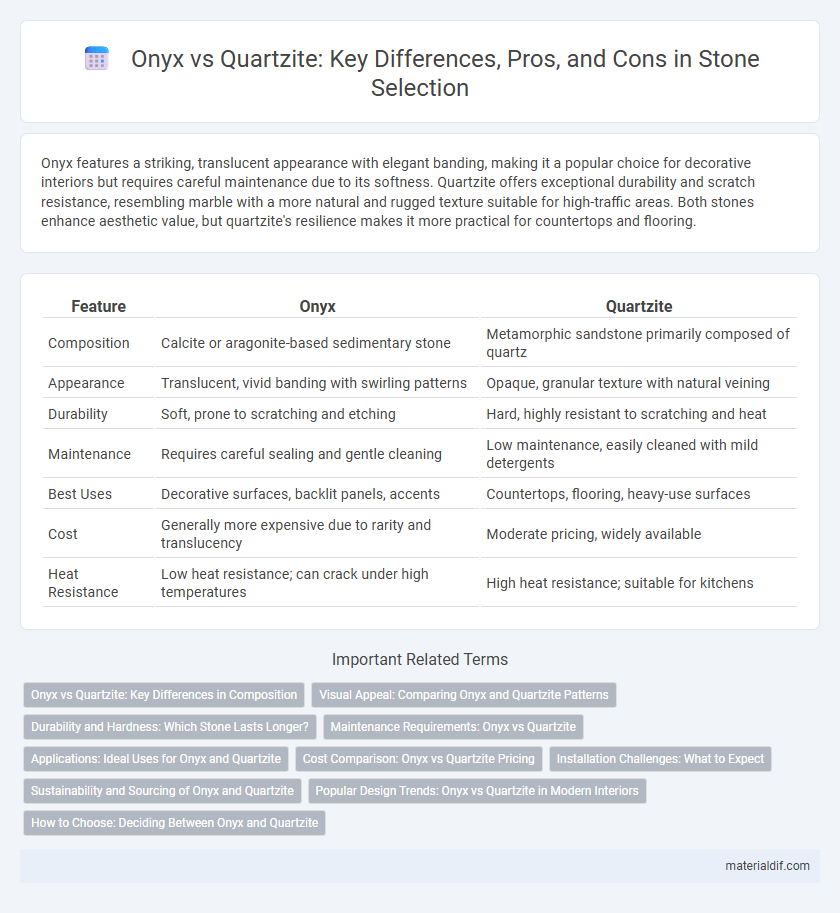Onyx features a striking, translucent appearance with elegant banding, making it a popular choice for decorative interiors but requires careful maintenance due to its softness. Quartzite offers exceptional durability and scratch resistance, resembling marble with a more natural and rugged texture suitable for high-traffic areas. Both stones enhance aesthetic value, but quartzite's resilience makes it more practical for countertops and flooring.
Table of Comparison
| Feature | Onyx | Quartzite |
|---|---|---|
| Composition | Calcite or aragonite-based sedimentary stone | Metamorphic sandstone primarily composed of quartz |
| Appearance | Translucent, vivid banding with swirling patterns | Opaque, granular texture with natural veining |
| Durability | Soft, prone to scratching and etching | Hard, highly resistant to scratching and heat |
| Maintenance | Requires careful sealing and gentle cleaning | Low maintenance, easily cleaned with mild detergents |
| Best Uses | Decorative surfaces, backlit panels, accents | Countertops, flooring, heavy-use surfaces |
| Cost | Generally more expensive due to rarity and translucency | Moderate pricing, widely available |
| Heat Resistance | Low heat resistance; can crack under high temperatures | High heat resistance; suitable for kitchens |
Onyx vs Quartzite: Key Differences in Composition
Onyx is a form of calcite composed primarily of calcium carbonate, characterized by its layered bands and translucency, often used for decorative purposes. Quartzite, a metamorphic rock formed from sandstone, consists mainly of quartz and is known for its durability and resistance to scratching. The key difference lies in their composition: onyx is a softer, more fragile calcium carbonate mineral, while quartzite is a harder, silica-rich stone ideal for high-traffic areas.
Visual Appeal: Comparing Onyx and Quartzite Patterns
Onyx displays striking translucency with swirling bands of vibrant colors, creating a dramatic and luxurious visual appeal often used in backlit applications. Quartzite features a more subtle, natural stone pattern with earthy tones and crystalline textures, providing durability alongside its sophisticated appearance. The choice between onyx and quartzite depends on whether bold, illuminated aesthetics or strong, textured elegance is desired for interior design.
Durability and Hardness: Which Stone Lasts Longer?
Onyx exhibits a Mohs hardness of around 3 to 4, which makes it relatively softer and more prone to scratching and etching compared to quartzite, which rates between 7 and 8 on the Mohs scale. Quartzite's superior hardness results in exceptional durability, making it highly resistant to wear, chipping, and acid damage. For applications requiring long-lasting stone surfaces, quartzite offers enhanced strength and longevity over onyx, especially in high-traffic or heavy-use environments.
Maintenance Requirements: Onyx vs Quartzite
Onyx requires delicate maintenance due to its porous nature and sensitivity to acids, needing regular sealing and gentle cleaning to prevent etching and staining. Quartzite offers superior durability with minimal maintenance, resisting scratches, heat, and stains without frequent sealing. Proper care of onyx involves avoiding harsh chemicals, while quartzite tolerates everyday use with simple cleaning routines.
Applications: Ideal Uses for Onyx and Quartzite
Onyx excels in decorative applications such as countertops, wall panels, and backlit features due to its translucency and striking vein patterns, making it popular for luxury interiors and artistic installations. Quartzite, known for its durability and resistance to heat and scratching, is ideal for high-traffic areas like kitchen countertops, flooring, and exterior cladding. Both stones offer unique aesthetics, but quartzite's hardness lends itself to functional and heavy-use environments while onyx is favored for aesthetic-driven, low-traffic spaces.
Cost Comparison: Onyx vs Quartzite Pricing
Onyx typically costs between $40 to $250 per square foot, reflecting its rarity and unique translucence, while quartzite ranges from $60 to $100 per square foot, valued for its durability and resistance to heat and scratching. The high-end pricing of onyx is justified by its luxurious appearance and the complexity of extraction and fabrication, whereas quartzite offers a more affordable yet resilient option suitable for high-traffic areas. Cost considerations for both stones should include installation and maintenance expenses, which tend to be higher for onyx due to its fragility compared to the more robust quartzite.
Installation Challenges: What to Expect
Onyx installation demands meticulous handling due to its translucency and brittleness, requiring reinforced substrates and specialized adhesives to prevent cracking. Quartzite, being harder and more durable, poses challenges primarily related to cutting and shaping, necessitating diamond-tipped tools and skilled labor to avoid chipping. Both stones require precise sealing post-installation to maintain their natural beauty and protect against staining or etching.
Sustainability and Sourcing of Onyx and Quartzite
Onyx and quartzite differ significantly in sustainability and sourcing, as onyx is a delicate, rare stone often extracted through environmentally sensitive mining practices that can result in habitat disruption and resource depletion. Quartzite, a naturally abundant and durable metamorphic rock, is typically sourced with less environmental impact due to its widespread availability and lower extraction intensity. Choosing quartzite supports more sustainable building practices by minimizing ecological footprint while onyx sourcing demands strict regulation to balance aesthetic value with environmental responsibility.
Popular Design Trends: Onyx vs Quartzite in Modern Interiors
Onyx and quartzite are favored materials in modern interiors, each offering distinct aesthetic appeals and durability features. Onyx is prized for its translucent properties and dramatic veining, making it a popular choice for statement pieces such as backlit countertops and wall panels. Quartzite, known for its strength and natural marble-like appearance, is widely used in high-traffic areas like kitchen countertops and flooring, aligning with contemporary design trends emphasizing both beauty and functionality.
How to Choose: Deciding Between Onyx and Quartzite
Selecting between onyx and quartzite depends on the desired aesthetic, durability, and maintenance requirements. Onyx offers dramatic translucency and unique patterns, making it ideal for decorative applications with less foot traffic, while quartzite provides superior hardness and resistance, suited for high-use surfaces like countertops and flooring. Consider the environment, usage intensity, and budget to choose the stone that balances beauty and practicality effectively.
Onyx vs Quartzite Infographic

 materialdif.com
materialdif.com